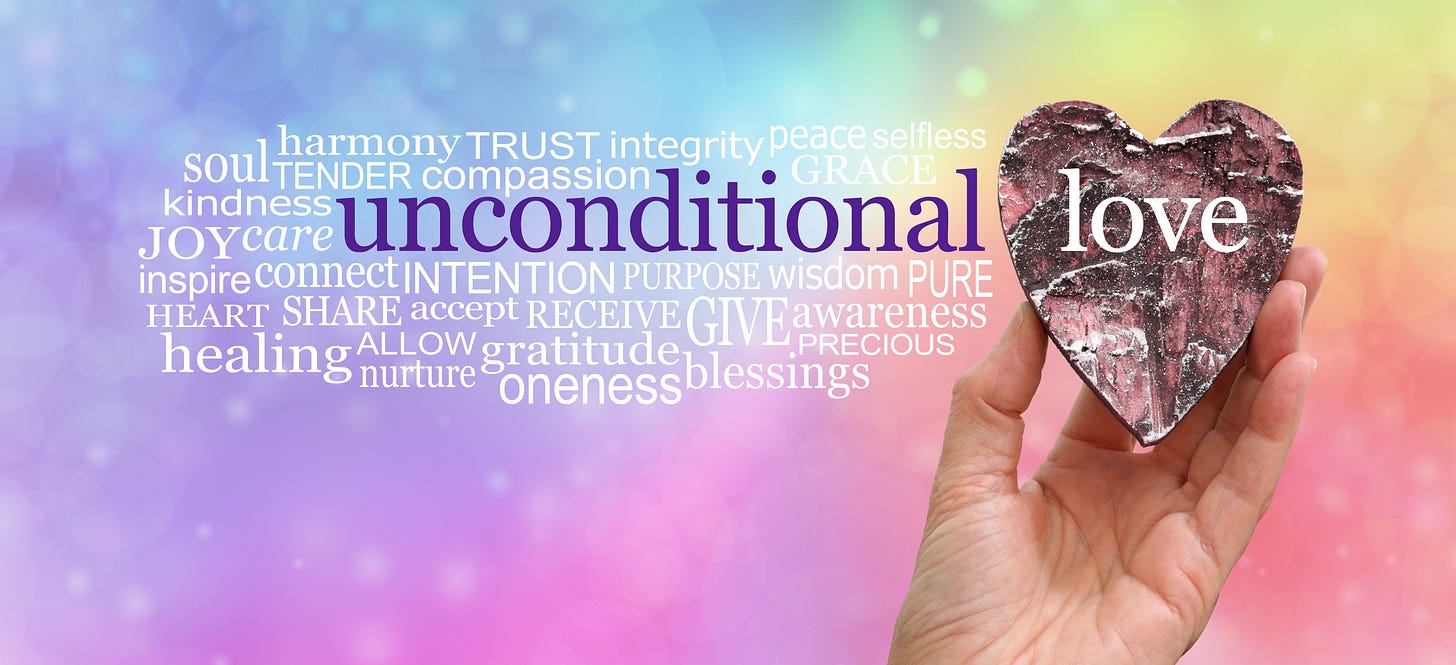When Our Image of God No Longer Works
Jesus, the Loss of Faith, and the Threat of Hell
In my post The Ocean and the Teacup (July 20), I speak about the tension between different ways of imagining or envisioning God: on one hand, the personal or anthropomorphic images of God, such as the classic “old man in the sky” and on the other hand, the more abstract/impersonal images that some people find more authentic or more consistent with their beliefs — for example, God as the cosmic source of love.
I believe that a healthy, expansive spirituality can be big enough to hold space for each of these perspectives. Each of us needs to be true to the images of God that are meaningful or inspiring for us, while also being non-judgmental toward those who find meaning in different images for the divine.
In my post, I used Santa Claus as a metaphor for how sometimes our images of God can change or evolve over time, just like a child might go from believing Santa is a literal being to understanding Santa as a metaphor for “the spirit of giving.”
One reader of that post, whom I’ll call “P.” wrote the following to me in response to that post.
I wish I didn't have to stop believing in Santa Claus as a child, much like I wish I didn't have to stop believing in Jesus (a personified God) as God right now. You can wrap yourself around mainstream Christianity (ie You can wrap yourself around Jesus), but you can't wrap yourself around mysticism. I notice you didn't mention Jesus once in your piece.
I realize you're saying I don't have to stop believing in Jesus as God, but at this point in my spiritual walk, I simply don't. I see Him as a personified symbol for God (a really good one, but still a symbol), like so many other religions' personified Gods.
I think it's sad when a child has to stop believing in Santa Claus (even if they retain the beautiful concepts and values that Santa represents). And I KNOW it's sad when someone stops seeing Jesus as God… Aside from being sad, it's also frightening. It deepens my sense of loneliness — nothing to wrap myself around. And then of course there's the religious trauma that part of me still carries: no faith in Jesus, hell for you!
There’s a lot here to unpack, and I probably can’t address it all. But I’ll try to hit a few high points.
Let’s begin at the end of this email, where P. acknowledges his experience of religious trauma (I am so sorry whenever I hear of people’s experience of trauma in religious settings, unfortunately it’s something many of us undergo). I feel like I need to comment on this, especially for any readers who may be struggling with their own traumatic fear of hell (eternal punishment).
So I have to be clear as I possibly can be, Here’s what I believe:
Threatening people with hell if they do not believe the “right” way is a form of religious abuse. People who make these kinds of theological threats are behaving in abusive ways.
There’s really nothing more to say here. I know that the notion of hell as a punishment for believing the “wrong” things is widespread among many conservative and fundamentalist Christians, across most denominations. But just because it is widespread doesn’t make it any less wrong.
With each passing year, so many children and youth are exposed to this toxic idea that if they don’t follow the accepted protocols of their faith community, they are at risk of spending eternity in conscious, unrelenting pain and torment, all engineered by the God they are expected to submit to.
Friends, this is a sick doctrine. It is a form of religious abuse, based on a monstrous image of God that is unworthy of human worship or obedience.
Can I say anything good about hell?
As I see it, the doctrine of hell only makes sense as a metaphor. Hell is a symbol, a symbol for the kind of suffering that unloving, abusive or hateful behavior can cause in people’s lives. When I say “Jesus wants to save us from hell” I believe this means that a healthy spirituality always offers an alternative to behavior that creates suffering, abuse, pain, and broken relationships — not only in eternity, but beginning here and now.
When we act in ways that cause suffering (in ourself or others), I believe God sees that as a spiritual sickness that needs healing, not as some sort of crime that requires excessive punishment.
Dear readers, if any of you are living with anxiety related to the fear that you will go to hell if you don’t believe the right things, please find a counselor or therapist who specializes in the healing of religious trauma. There is a path out from abusive religion. You do not have to settle for a life of suffering.
What about Jesus?
In his email, P. points out that I did not even mention Jesus in my previous post. That is correct, as I was specifically writing about images of God, or what trinitarian Christians might call “God the Father” — so Jesus, especially the earthly figure Jesus of Nazareth was not my concern. But I know that for many Christians, Jesus is God, and the great mystic Julian of Norwich points out that whenever she speaks of Jesus, she is speaking of God. Naturally, I respect that many Christians equate Jesus with God, or at least have an understanding of Jesus as “the son of God” or the incarnation of God.
The question of personalist versus impersonalist images of the divine can apply to Jesus. Theologians like to speak of “the Jesus of History” and “the Christ of Faith.” This is also related to the Christian doctrine that Jesus is “fully human, fully divine.” For many people, there can be a distinction between thinking of Jesus as a flesh and blood human being who was born, lived, and died, and thinking of the Christ as a more heavenly, eternal figure, who “in the beginning was the Word” and who is seen as having been resurrected, ascended to heaven, and now is able to send us the Holy Spirit and watch over us as the second person of the Trinity.
For some people, it’s easier to relate to the human Jesus. For others, it’s easier to relate to the “cosmic Christ.” It seems to me that this is a parallel to relating to God in anthropomorphic ways versus relating to God as an abstract symbol for “the Divine.”
But P. is not just commenting on the fact that I didn’t mention Jesus — he was also lamenting how his own faith in Jesus once was strong but more recently has been lost.
And like many people, P. experiences this loss of faith as deeply sad, if not somewhat frightening. It gives him a sense of spiritual loneliness.
I think it’s helpful to recognize that faith goes through seasons and stages, even in the most “ordinary” of lives. The symbols and images of God/Christ/Spirit that work for us when we are 10, or 25, or even 50 years old, often will eventually lose their power and meaning as life progresses. This is due to many factors, not the least of which is that as we progress through the stages of our lives, our spiritual needs naturally will evolve and change. I’m in my mid-60s which means these days I tend to be concerned with financial stability, health, accepting the reality of friends and family aging and dying, and being a supportive presence in the lives of loved ones who are younger than me. None of those issues were even on my radar 20 or 40 years ago. In a very real way, I’m a different person now than I was half a lifetime ago. Is it any wonder that my spiritual needs will have changed, as my social and psychological needs have changed as well?
Churches and other religious communities are like Instagram or other social media sites: they tend to reward those who put on the best show, and ignore if not marginalize those whose experience seems more vulnerable, wounded, or uncertain. What this means is that in religious circles there tends to be an “image is everything” culture, where the unspoken rule is that it’s not okay to show off our doubts or questions or uncertainties. Consequently, many people who find that they are struggling with their faith often feel that they are all alone, that there’s no one they can confide in or who will listen to them as they struggle to make sense of how their experience of faith is changing.
In his wonderful book Faith After Doubt, Brian D. McLaren acknowledges that many people of faith — even those in ministry or who have been “pillars of the church” — find that their faith can change or even die over time. McLaren is wise and doesn’t try to just sweep this under the rug, but rather encourages anyone who is experiencing deep doubt to lean into their experience and trust that it can take them to a new place of meaning and purpose.
This is where I think the different strands of P.’s email come together. Mystics know that sometimes the old images of God no longer work for us. This is just as true for our images of Christ as our images of God. What can feel like a loss of faith might also be an invitation into a new and radically different experience of God/of faith. Unfortunately, some people in our churches and communities may feel frightened by this kind of transition, and sometimes resort to abusive or traumatizing doctrines (like the threat of everlasting hell) to try to keep people in line.
But that never works — usually it just pushes people away.
A much more skillful response is to embrace the fact that, underneath all religious beliefs and doctrines, is the deep unknowing that can feel like “losing faith” but sometimes might be more like a caterpillar descending into a cocoon, an experience that might feel like (spiritual) dying but that is necessary for the butterfly of a deeper, more mystical faith to emerge.
I am sorry that many people like P. feel such sadness over the transition of faith like what he appears to be undergoing. It is my experience that many churches are woefully unprepared to help people undergoing this type of deep transition. The fact that he says he feels “alone” confirms my suspicion that his church has let him down. But sadly, many churches are not equipped to support the transition from conventional to contemplative faith — or from conventional religious observance to mystical spirituality.
Is it sad when a child has to abandon the childish belief in Santa Claus? Sure — but that’s like saying it’s sad when they lose their first set of teeth. Those teeth need to go, to create room for the larger, sturdier adult teeth that will emerge in their place. Just like abandoning the childish belief in Santa Claus creates the psychological room for belief in abstract values like generosity, abundance, hospitality, and sharing, so too the loss of an original faith in Jesus (or God, or both) can be a transition into a richer and fuller — but not literalistic or dualistic — faith in the Mystery of Love.
If you enjoy Fullness of Joy, please consider subscribing to my other newsletter, Mystical Journey — which consists of shorter, more inspirational/devotional writings designed to support contemplatives and aspiring mystics. Click here to subscribe.





